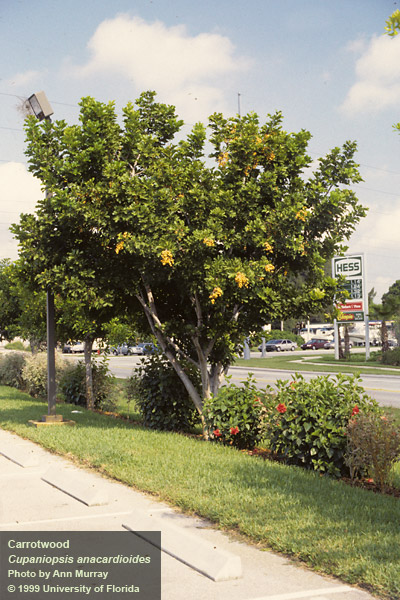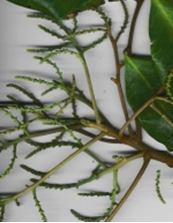University of Redlands Emergency Alert System
Alert Received: . For more information, visit: https://www.redlands.edu/alert/
University of Redlands
- Home
- Trees
- Species Accounts
- Carrotwood
Common Name: Carrotwood
Scientific Name: Cupaniopsis anacardioides
Family: Sapindaceae
Identification
Habit: The Carrotwood can grow up to 40 feet and have a spread of 30 feet and grow 12 to 24 inches per year 2. It is described as a tree with a low canopy and evergreen foliage.
Figure 1. The overall habit of a Carrotwood tree7
Leaves: Leaves are a dark green color with a glossy appearance and a leathery texture. They are even pinnately and compound and the leaves are at a length of 4 inches and at a width of 3 inches with long oval leaflets or oblong leaflets. On each compound, there are about 4-12 leaflets. The sides of the leaves are smooth with the tips being slightly rounded.3
Figure 2. Close up of a Carrotwood leaf9
Twigs and Bark: Carrotwood has gray outer bark that has a rather smooth texture. The inner bark layer that is orange. This tree is typically has a single trunk. Twigs are thin and a brownish-gray color.3
Figure 3. Close up image of Carrotwood twigs11

Figure 4. Image showing both the outer and inner layers of bark8
Flowers and Fruits: Flowers bloom in winter and have a white color and the tree is monoecious. They are in branched clusters measuring up to 14 inches and have five petals and 6-8 stamens. The fruit grows in the summer and has an orange/yellow capsule that can be between a quarter of an inch to half an inch in size and grows in clusters.3
Figure 5. Close up image the Carrotwood’s flowers10
Figure 6. Close up image of the Carrotwood’s fruit.4
Where it’s from
Native range: Australia, Irian Jaya (Indonesia), and Papua New Guinea
Ecological notes: Carrotwood can pose an ecological threat, especially to coastal ecosystems. Carrotwood is an invasive species, causing other native species of plants to die out, When the native species are no longer there, this affects the coastal ecosystems since they rely on natural erosion control provided by their native species of plants (like mangroves) which Carrotwood cannot provide.6 The brightly colored fruit is attractive to birds, so the main dispersal method is through this. They are both pollinated by bees in their native range and in Florida (the most common location for Carrotwoods to grow outside of their native range).
What we use it for
Carrotwood is used for aesthetic reasons because the fruit and tree wood doesn’t provide any use and it doesn’t create excessive litter. It is described as an undemanding plant to take care of and is relatively easy to raise for those reasons.
References
Biographer
Bianca Sandoval ‘22, BIOL 238: Evolution, Ecology, and Behavior, Spring 2020